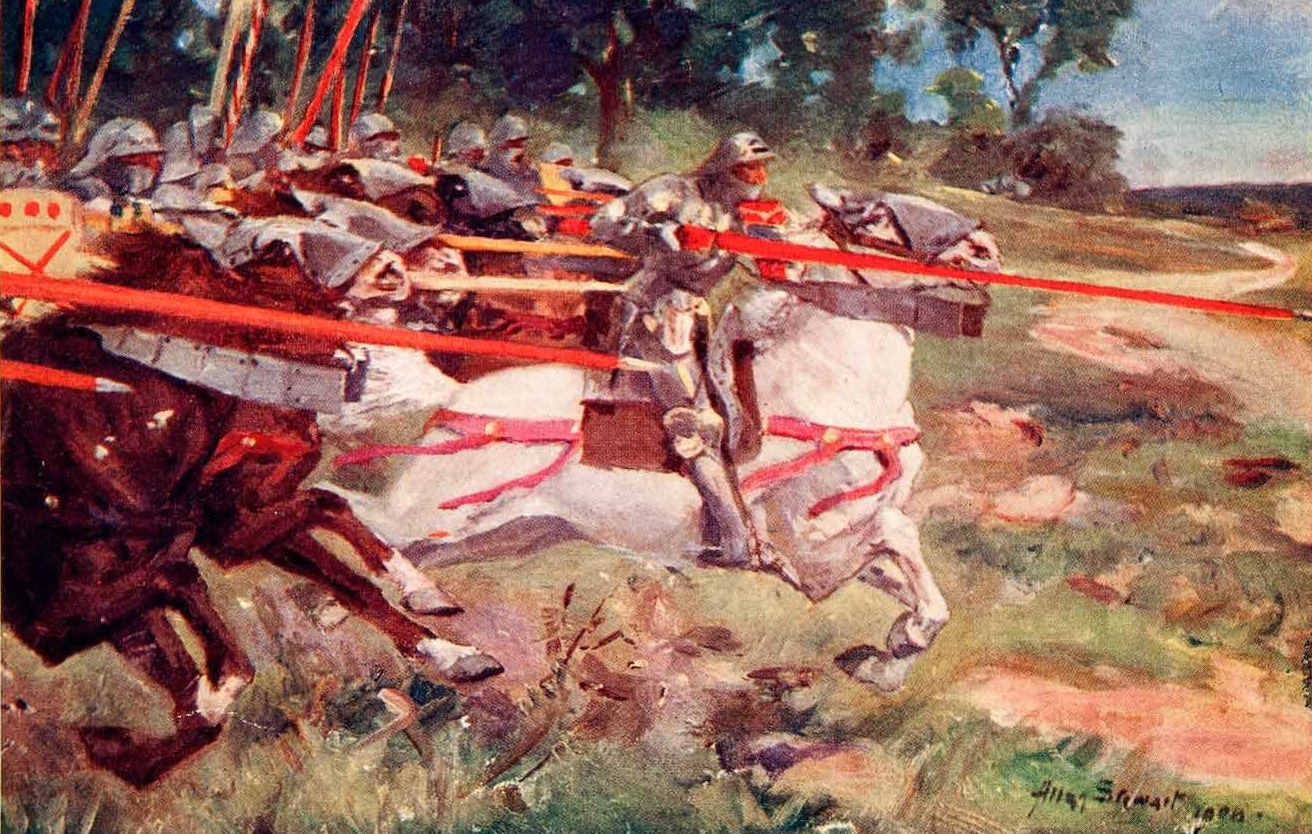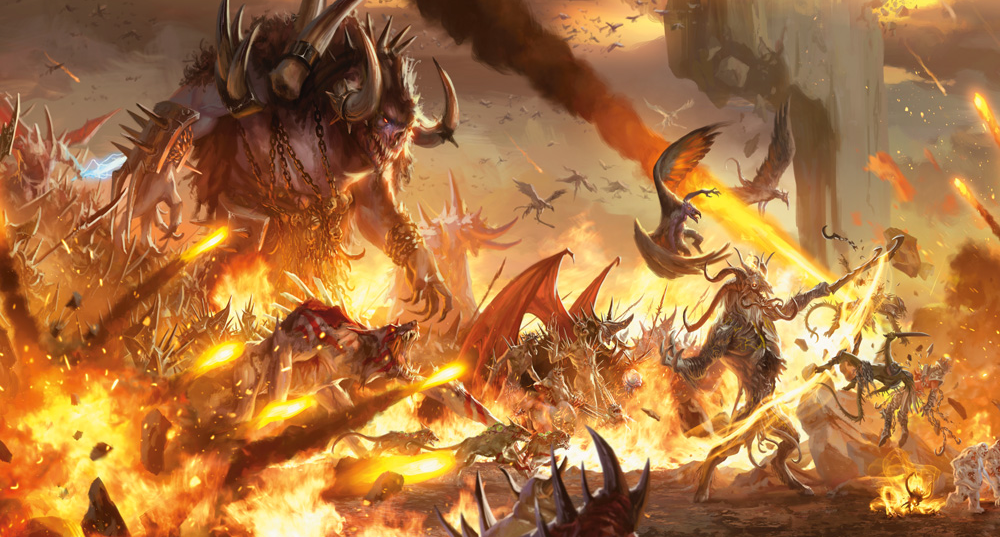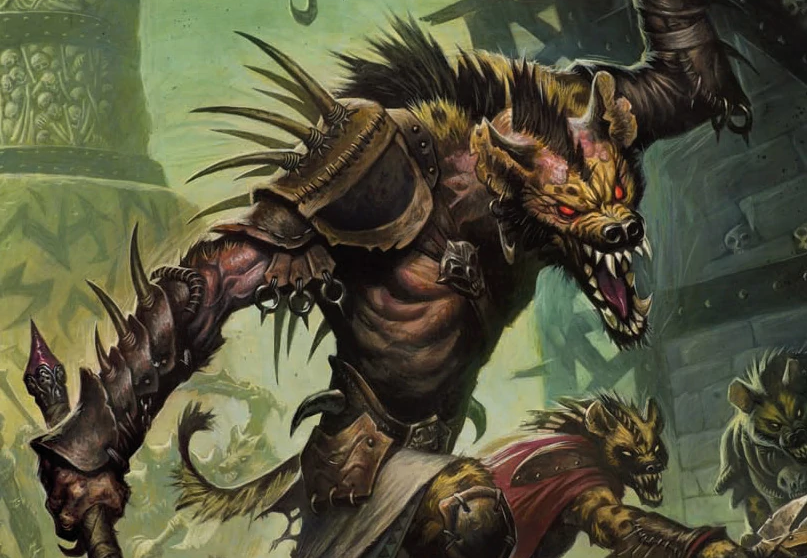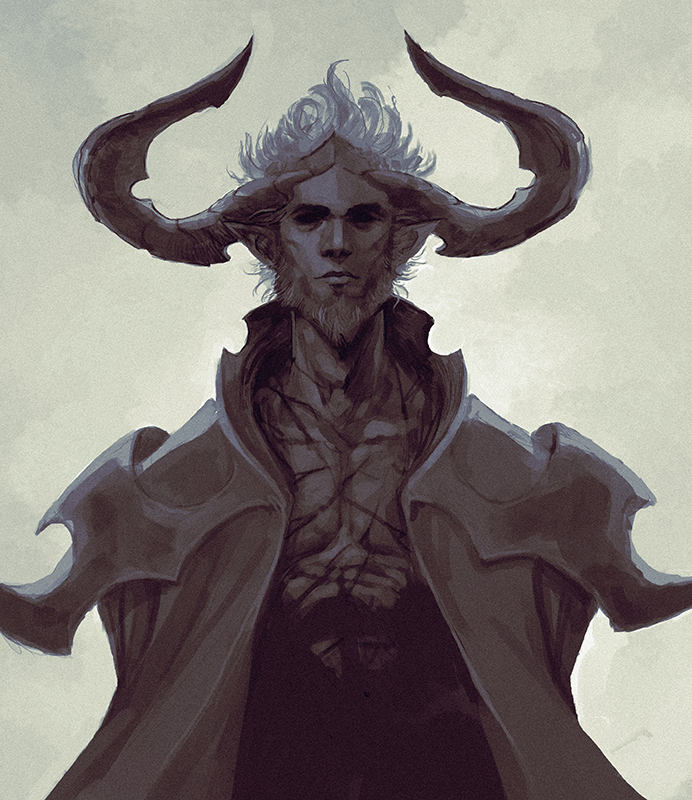
LEGEND OF THE HELLRIDERS
Now that we’ve established the definitive truth of these events, let’s take a moment to look at how the story has been passed down to the modern day. How are the Hellriders remembered in Elturel and on the Sword Coast?
This material will be useful if any of the PCs are playing Hellriders (or, really, any Elturian characters). Or when they hear the legend at some point in the pre-Avernus part of the campaign (e.g., when speaking with Reya Mantlemorn or another Hellrider). I’ve included some additional notes in square brackets that can be used to expand the basic version of the legend if the PCs decide to do some detailed research into the legend (in Candlekeep, for example).
THE FIRST HIGH RIDER: Before humans came to Elturel, the site was ruled by an Ogre Lord in a crude stone bastion atop the tor where now stands the High Hall. The Ogre Lord captured the son of Lady Shiarra, a local noblewoman. Lady Shiarra, seeking vengeance against the Ogre Lord, drove him out of the bastion. [Other versions of the story claim that the Ogre had stolen Lady Shiarra’s sword or horse. One version says the Ogre was her son. If you asked a sufficiently erudite ogre about the matter, they’d probably have different opinions about the legitimacy of Lady Shiarra’s actions in general.]
After the Ogre Lord was defeated, Lady Shiarra called a concord of local lordlings to the site where Shiarra’s Market now stands (see Part 5C). These lordlings pledged fealty to each other and formed the Riders of Elturel, with Lady Shiarra as the first High Rider.
OTHER TALES OF THE RIDERS OF ELTUREL: There are a variety of chivalric stories featuring the early Riders of Elturel. The most common themes include:
- A lone Rider heads out from the city and faces evil. (Pick any monster from the Monster Manual.) Sometimes they are seeking that evil. Other times they stumble upon it in unexpectedly idyllic places.
- Romantic tourneys in which Riders (often with a mixture of foreign knights) face each other in various games of martial skill while sexual tension kindles between rivals. These tales usually feature a shapeshifter posing as a knight or otherwise confusing identities.
- Minor crusades, in which troops of Riders sally forth to save an entire community (usually in response to a plea for help). [These tales are generally told and have been shaped to support Elturel’s role as “protector” of the surrounding lands.]
THE CHARGE OF THE HELLRIDERS:
- Olanthius, the High Rider of Elturel, was often away from the High Hall, for the frontiers in those days were sore-pressed by warbands passing over the Sunset Mountains from the Goblin Marches. Fields were despoiled, livestock slaughtered, homes razed, and people dragged off to terrible fates. [When, exactly, Olanthius ruled Elturel is uncertain, but generally agreed to be the 9th or 10th century, although some claim it’s as far back as the 8th. Some of the early chronicles say that the trouble actually originated from the Trollclaws and not the Goblin Marches, although some loremasters argue that both might be true.]
- While Olanthius was away, a Prince of Devils came to Elturel. Cloaked in a handsome form, he insinuated himself into the High Hall as Nothius, a Lord of Iriaebor. Over time, he enslaved the soul of Olanthius’ love, the Lady Yael. [The early-14th century poet Aternicus wrote “The Lay of the Lady Yael,” a now-classic masterpiece which weaves this story into a romantic seduction.]
- As winter fell upon another year, Olanthius returned from campaign over fresh-fallen snow to discover that his lady love had been stolen away. Alack! If only he had returned a few hours earlier, Lady Yael might have been saved! [In some versions of the story, Olanthius is now visited by a nameless angel who guides the Riders to where Yael is being held prisoner.]
- Olanthius led the Riders of Elturel in a frenzied chase. [Maatal’s Chronicle instead describes a search of eighteen months – in some versions, eighteen years – in which the Riders of Elturel scatter across Toril, seeking the hiding place where Prince Nothius has concealed Lady Yael. Various tales have accumulated to individual knights, some of whom journeyed to distant Zakhara and even Maztica.]
- When the Riders caught up with Lord Nothius, the devil revealed his true form. A great battle then commenced, which ended when Nothius opened a gateway to Hell itself and, with a cackling laugh, carried Lady Yael through it! [Several chronicles also ascribe the goblin or troll invasions as being part of Nothius’ schemes; these usually feature a ferocious battle as Olanthius and the Riders try to fight their way through to Nothius. In other versions, Nothius has carried Lady Yael to a citadel in the Sunset Mountains – sometimes identified as Darkhold – and the Riders must lay siege to it.]
- The Riders of Elturel did not hesitate! They plunged through the gate, pursuing the devil into Hell itself! [Some versions of the story have the Riders pursue the devil Nothius through all nine of the Hells. In these, Nothius is often revealed to be Asmodeus himself. These are generally agreed by serious historians to be exaggerations.]
- The pursuit of Nothius now continued across the blasted plains of Avernus itself. At last, the Riders of Elturel met the armies of Hell! The Riders defeated one of the fabled blood legions and Yael was reunited with Olanthius, but as they rode back towards the portal home a second and even larger legion threatened to cut them off.
- Olanthius knew the only hope of escape was if this legion was delayed. He asked for volunteers to accompany him… and all the Riders did so. Therefore lots were drawn to determine the lucky few who would ride one last time at the side of their lord. Olanthius begged Yael to fly to safety, but she, too, chose to ride into battle at his side.
- In the face of the Riders’ charge, the legion of Avernus trembled and buckled… but did not break. Olanthius and Yael perished on the Avernian plains. It is said that where they fell in a final, martial embrace, a spring of holy water sprung up that was poison to the devils of that land.
- Their sacrifice, however, bought the time the other Riders needed to escape from Hell. Overcome with grief at the loss of their glorious leader and his love, they returned to the city. Their valor was never forgotten, and from that day forward the Riders of Elturel were known as the Hellriders.
As you can see here, much of the true history has been lost. Or, rather, distorted through a storied tradition — a golden age of Elturian chivalry which has been artificially extended back to the founding of the city to culminate triumphantly in the great tale of the Charge of the Hellriders. Thus the earliest Lords of Elturel (including Lady Shiarra) have become retroactively identified as High Riders.
Design Note: This sort of thing isn’t without precedent in the real world. See, for example, how the “Roman Emperors” would have been contemporaneously identified as Imperator, Augustus, and/or Caesar. Or the Arthurian tradition, in which history becomes encrusted with literary invention.
If the PCs decide to do some deep investigation along these lines, you could certainly hint at the uncertainty of the historical record here. Although even these hints wouldn’t necessarily be accurate: For example, you might discuss how the loremaster Alice Messier of Iriaebor has recently done a study of “Jander Sunstar.” Supposedly the High Rider who led the Riders of Elturel out of Hell, Messier has found references to another “Jander Sunstar” as a folk hero in the Dalelands whose stories were later merged with a set of vampiric myths arising from the infestation of vampires that led to Merrydale becoming Daggerdale. The obvious conclusion, of course, is that “Jander Sunstar” never actually existed, and the Dalelands folk hero was simply incorporated into the chivalric cycle of Elturel.
If you want to get ambitious, you could develop some lore books along these lines and perhaps distribute them in likely places in Elturel and/or Candlekeep.
LORE OF ZARIEL
Once the PCs become aware that they’re dealing with Zarielite cultists in Baldur’s Gate, they may want to do some research into who Zariel is. This might also be true in Candlekeep after Lulu’s revelation that Zariel was involved in the Charge of the Hellriders. So it’s worthwhile to briefly consider what they’ll find in the history books.
You can also use this information to inform Intelligence (History) and Intelligence (Religion) checks.
Design Note: The general theory of my approach here is that (a) Hell exists, but (b) it is very, very far away from the Material Plane. Thus the loremaster’s understanding of Hell is akin to a scholar of Medieval Europe’s understanding of the fine details of Japanese history (i.e., incredibly poor bordering on the mythical). The history of Hell also stretches back across aeons unimaginable to human history. Plus the entire place is inhabited entirely with gifted liars whose interactions with humans are usually based entirely around deceiving them.
AVERNIAD & THE TRIAL OF ASMODEUS: These early events in planar history are known to mortal scholars, but are mostly obscured through a haze of confusing legendry. Zariel’s name is not associated with them, although the incident in which a nameless angel started a deific brawl during the Trial of Asmodeus might crop up.
It’s up to you how much chaff you want to throw up around the “true history of Asmodeus and/or Hell” if the PCs start looking into it. We’re greatly aided in this, however, because D&D itself has published a bunch of contradictory versions of this continuity:
- Serpents of Law: Asmodeus, then known as Ahriman, and Jazirian arose from the primal chaos as powerful serpent gods. The two serpents bit each others’ tails and formed a great circle whose turning transformed chaos into the order of the Great Wheel. The two serpents quarreled, stripping each other of god-stuff. The diminished Asmodeus, a wingless serpent, crashed into Nessus, the First Hell, while the winged Jazirian rose to Mount Celestia.
- Angelic Fall: When the first gods grew weary of fighting demons, they created angels to continue the battle for them. The first of these angels was Asmodeus. Over time, Asmodeus assumed more and more control of the war, with the gods formalizing more and more of his authority in the form of pacts. There came a time when the gods realized that Asmodeus had created a vast and horrific infrastructure for torturing mortal souls (i.e., Hell) and transforming them into foot soldiers (i.e., devils) – call it the military-infernal complex. Asmodeus was put on trial, but he simply pointed to the tangled web of pacts and declared that the gods had authorized all of it. Primus of the Modrons, who acted as the trial’s judge, ruled in Asmodeus’ favor, and the collection of pacts became known as the Pact Primeval. It remains the bedrock of celestial law.
- He Who Was: Asmodeus was once an exarch serving He Who Was. (Asmodeus would later go to considerable lengths to wipe out all record of the god’s name, leaving only the enigmatic title.) He Who Was was the ultimate god of law. To preserve a perfect order, He Who Was controlled every single aspect of reality, down to the smallest details. In his demesne, the mortal races did not yet have free will – they were automatons going through the motions of civilization. Asmodeus was no different, until he was corrupted by the demon lord Pazuzu. With the scales fallen from his eyes, Asmodeus saw clearly the tyranny of the Law according to He Who Was. After a quiet resistance (that may have lasted for centuries and also ties into the Dawn War waged against Tharizdun), Asmodeus journeyed to the bottom of the Abyss and found there the shard of freedom (which some “fools” have named the shard of evil) and crafted from it his Ruby Rod. The rod’s existence shattered the control of He Who Was (and, in some heretical texts, is claimed to be the basis for all mortal consciousness). Asmodeus slew He Who Was.
Note: Some gnostic cults claim that the breaking of the Perfect Order is much more recent than one would suspect: Some claim it only happened a few short years ago. Others cite the Spellplague or the Sundering. For esoteric reasons, the date of 1358 DR is frequently given – the Year of Shadows in which mortals ceased to be mere shadows and became fully realized and autonomous spirits. In any case, according to the gnostics, all recorded history before that point was merely acted out according to the whim of He Who Was; the historical personages not truly possessed of what modern mortals understand as consciousness.
CHARGE OF THE HELLRIDERS: Zariel’s name is also not associated with the Charge of the Hellriders in any way (see above).
ZARIEL – WHAT IS KNOWN:
- Zariel was one of the Dark Eight, the council of generals who lead Hell’s legions in the Blood War.
- She is believed to be a fallen angel, likely one of those who first followed Asmodeus to Hell, making her one of the oldest and probably most powerful devils.
- During the Reckoning – the War in Hell that turned Lords of Hell against each in the 13th century – Zariel initiated hostilities by forming an alliance with Tiamat and leading an army to besiege Dis, the second layer of the Nine Hells.
- Near the end of the Reckoning, Tiamat betrayed Zariel and the siege on Dis was broken. Zariel was imprisoned in Tiamat’s citadel.
- At the beginning of the 15th century, Avernus – the first layer of Hell – was in a state of tumult. The Blood War was going poorly. Zariel escaped from Tiamat’s prison, raised an army, and turned the tide. To reward her, Asmodeus deposed Bel – who had been the Archduke of Avernus – and raised Zariel in his place.
- Zariel has been the Archduchess of Avernus ever since. A cruel and brutally effective military leader.
Note: It’s possible that the inner mysteries of some Zarielite cults would preserve the knowledge that Zariel led the Charge of the Hellriders. From a practical standpoint, however, the PCs should not be able to learn this from the cultists in Baldur’s Gate. (The knowledge should drop in Candlekeep, as described in Part 4C.) If you want to add this sort of deep lore to the Zarielites, I’d recommend confining it to the revelation that she was a fallen angel and perhaps very early events pertaining to the Averniad and the Trial of Asmodeus.
WHAT DOES GARGAUTH KNOW? If the PCs get the Shield of Hidden Truth and question Gargauth, he can provide a lot more detail. (These same general guidelines can probably be used for other denizens of Hell, other than those with personal first-hand knowledge.)
- Gargauth is not familiar with Zariel’s role in the Charge of the Hellriders, but he knows that she was an angel who fell comparatively recently (within the last few centuries).
- Having been active in Elturel for decades, he’s familiar with the Legend of the Hellriders (and can probably provide an account of many of its variations and details).
- He can provide detailed accounts of the Averniad and the Trial of Asmodeus. (He even knows that Zariel sparked a brawl during the trial.) However, it might amuse him to muddle things up with false tales (like those described above).
- He knows the Reckoning and the Rift War in detail.



 first time in centuries, the Avernian frontiers were in utter disarray. Although no alliance was formed between the baatorians and demons, armies of both races freely crossed the Styx.
first time in centuries, the Avernian frontiers were in utter disarray. Although no alliance was formed between the baatorians and demons, armies of both races freely crossed the Styx.
















